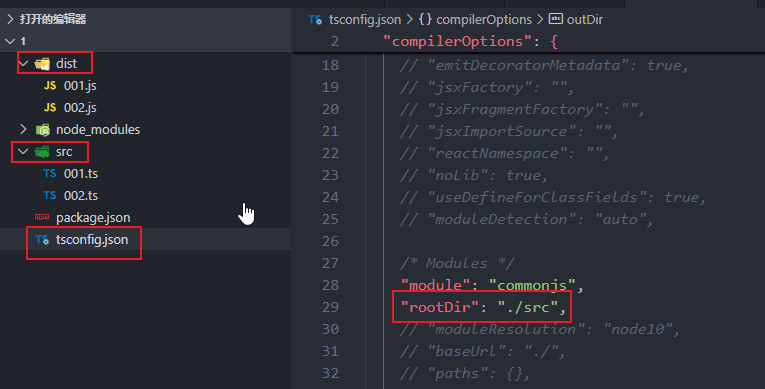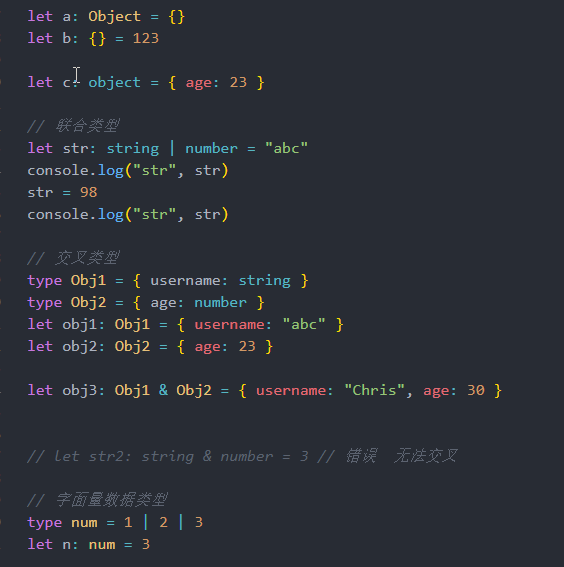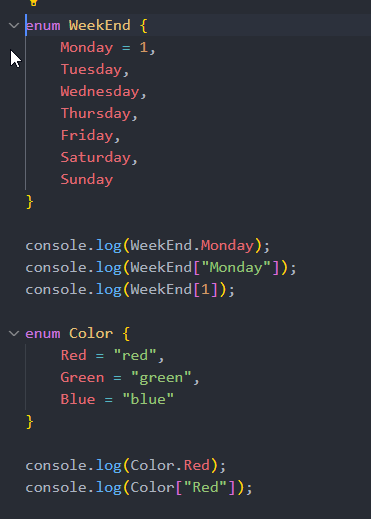什么是TypeScript
融合了后端面向对象思想的超级版的javaScript 语言。
环境搭建
1
2
3
| npm init -y
yarn add typescript -D
tsc --init
|
优势
- 优势1:编译时静态类型检测:函数或方法传参或变量赋值不匹配时,会出现编译错误提示 ,规避了开发期间的大量低级错误,省时,省力。
- 优势2:自动提示更清晰明确。
- 优势3:引入了泛型和一系列的 TS 特有的类型。
- 优势4:强大的 d.ts 声明文件:声明文件像一个书的目录一样,清晰直观展示了依赖库文件的接口,type类型,类,函数,变量等声明
- 优势5:轻松编译成 JS 文件:即使 TS 文件有错误,绝大多数情况也能编译出 JS 文件。
- 优势6:灵活性高: 尽管 TS 是一门 强类型检査语言,但也提供了 any 类型 和 as any 断言,这提供了 TS 的灵活度。
类型注解与推导
1
2
3
4
5
6
7
8
9
10
11
12
13
14
15
16
17
18
19
|
let data: number = 3
let money = 30
interface Student {
name: string,
age: number
}
let stu: Student = {
name: "",
age: 0
}
export {}
|
编译与优化
tsconfig.json文件里 修改 “rootDir”: “./src” 与 “outDir”: “./dist” 源文件与编译后文件

然后在项目根目录 输入 tsc 执行编译, src里面的文件都会按照commonjs规范编译出dist里的文件

常用的24种TS类型
基本类型:
number, string ,boolean, symbol, null, undefined
根类型: 所有其他数据类型的父类
Object, {} // 大括号是Object的简写
对象类型:
Array, object, function
枚举:
enum
其他特殊类型:
any,unknown,never,void,元组(tuple),可变元组
合成类型:
联合类型,交叉类型
字面量数据类型:

枚举的定义,分类,取值方式
用来存放一组固定的常量的序列 包括字符串枚举和数字枚举

any与unknown
相同点: any 和 unknown 可以是任何类的父类,所以任何类型的变量都可以赋值给 any 类型或 unknown类型的变量。
不同点1:any 也可以是任何类的子类,但 unknown 不可以,所以 any 类型的变量都可以赋值给 其他类型的变量。
不同点2:不能拿 unknown 类型的变量来获取任何属性和方法,但 any 类型的变量可以获取任意名称的属性和任意名称的方法。
1
2
3
4
5
6
7
8
9
10
11
12
13
14
15
16
17
18
19
20
|
let str:string = "hello world"
let data: any = str
let data2: unknown = str
let data3: any = undefined
let array:any = ["a", "b"]
let array2:Array<string> = array
function getData(data:any):any{
return data.name
}
|
接口
另一种定义对象类型的类型
可以为多个同类别的类提供统一的方法和属性申明
1
2
3
4
5
6
7
8
9
10
11
12
13
14
15
16
17
18
19
20
| interface Product {
name: string
price: number
account: number
buy(): void
}
let p: Product = {
name: "",
price: 0,
account: 0,
buy: function (): void {
throw new Error("Function not implemented.")
}
}
interface Student extends Product {
id: number
}
|
可索引签名
1
2
3
4
5
6
7
8
9
10
11
12
13
14
15
16
17
18
| interface Product {
name: string
price: number
account: number
[x: string]: any
}
let p: Product = {
name: "",
price: 0,
account: 0,
info: "hello",
100: "hello",
buy: function (): void {
throw new Error("Function not implemented.")
}
}
|
null 和 undefined
1
2
3
4
5
6
7
8
9
10
11
12
13
14
15
16
17
18
19
20
| const str: string = "abc"
console.log(str.length)
let str2: string | undefined = undefined
console.log(str2)
function fn(data?: string) {
}
fn()
let data: any = undefined
|
函数和函数类型 rest参数
1
2
3
4
5
6
7
8
9
10
11
12
13
14
15
16
17
18
19
20
21
22
23
24
25
26
27
28
29
30
31
32
33
34
35
36
|
function info(name: string, age: number): number {
console.log(name, age)
return 3
}
info("hello", 3)
let info2 = function (name: string, age: number): number {
console.log(name, age)
return 3
}
info2("hello", 3)
let info3: (name: string, age: number) => number =
function (name, age): number {
console.log(name, age)
return 3
}
info3("hello", 3)
type InfoFunType = (name: string, age: number) => number
let info4: InfoFunType =
function (name, age): number {
console.log(name, age)
return 3
}
info4("hello", 3)
function info5(name: string, age: number, ...rest: any): number {
console.log(name, age, rest)
return 3
}
info5("", 23, "123", 456, 789)
|
元组
满足以下3点的数组就是元组
(1)在定义时每个元素的类型都确定
(2)元素值的数据类型必须是当前元素定义的类型
(3)元素值的个数必须和定义时个数相同
1
2
3
4
5
6
7
8
9
10
11
12
13
14
15
16
17
| let salary: [string, number] = ["hello", 100]
const arr = [10, 20, 30, 40, 50] as const
let arr1: [number, ...string[]] = [1, "hello", "world"]
let [age, ...rest]: [number, ...string[]] = [1, "hello", "world", "world"]
console.log(age, rest)
let [age1, name, ...rest1]: [age1_: number, name_: string, ...rest_: string[]] = [1, "hello", "world", "world"]
console.log(age, rest)
|
类
1
2
3
4
5
6
7
8
9
10
11
12
13
14
15
16
17
18
19
20
21
22
23
24
25
26
27
28
29
30
31
32
33
34
35
36
37
38
39
40
41
42
43
|
class People {
name: string
age: number;
addr: string;
constructor(name: string, age: number, addr: string) {
this.name = name;
this.age = age;
this.addr = addr;
}
}
class People2 {
name: string
age: number;
addr: string;
static people: People2
static getInstance(): People2 {
if (!People2.people) {
People2.people = new People2("李四", 20, "上海")
}
return People2.people
}
constructor(name: string, age: number, addr: string) {
this.name = name;
this.age = age;
this.addr = addr;
}
sayHi() {
console.log("Hi")
}
}
const p2 = People2.getInstance()
const p3 = People2.getInstance()
console.log(p2 === p3)
|
泛型
具有以下特点的数据类型叫泛型
特点一:定义时不明确使用时必须明确成某种具体数据类型的数据类型。【泛型的宽泛】
特点二:编译期间进行数据类型检查的数据类型。【泛型的严谨】
1
2
3
4
5
6
7
8
9
10
11
12
13
14
15
16
17
18
19
20
21
22
23
24
25
26
27
28
29
30
31
32
33
34
35
36
37
38
39
40
41
42
43
44
45
46
47
48
49
50
51
52
|
interface Ref<V> {
value: V
}
let ref: Ref<string> = { value: "23" }
type Student = { name: string, age: number }
let ref2: Ref<Student> = {
value: {
name: "wangwu",
age: 23
}
}
ref.value
ref2.value.name
class ArrayList<T> {
arr: Array<T>
constructor() {
this.arr = []
}
add(ele: T) {
this.arr.push(ele)
}
get(index: number): T {
return this.arr[index]
}
}
class MyArrayList<T = any> {
arr: Array<T>
constructor() {
this.arr = []
}
add(ele: T) {
this.arr.push(ele)
}
get(index: number): T {
return this.arr[index]
}
}
let arr = new ArrayList<string>()
function quickSort<E> (arr: E[]) : Array<E> {
return arr
}
|



